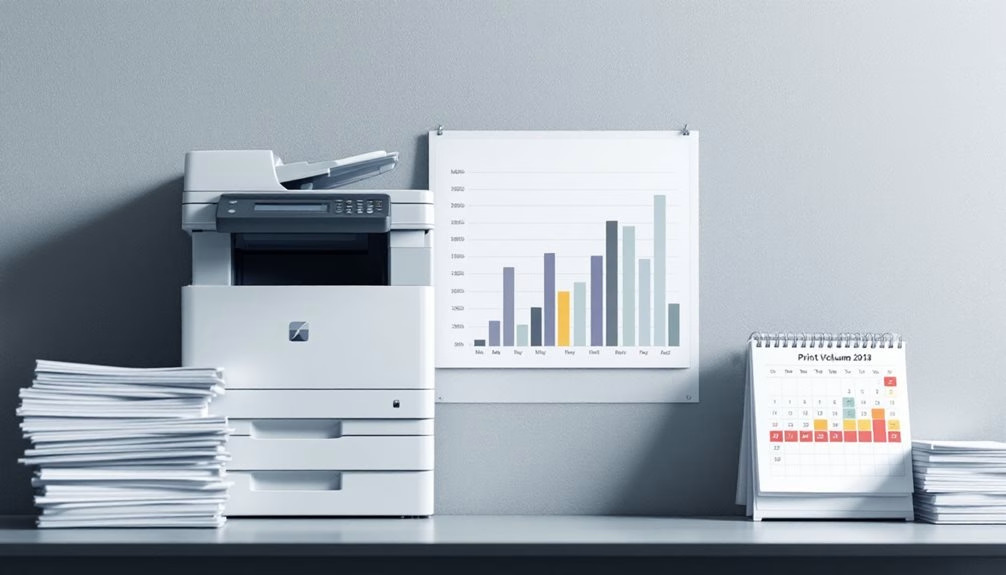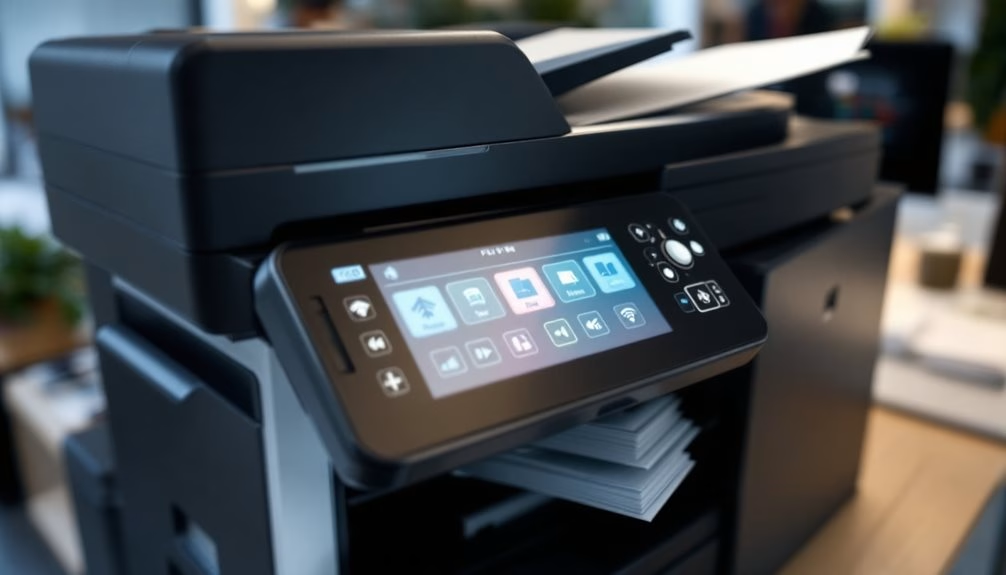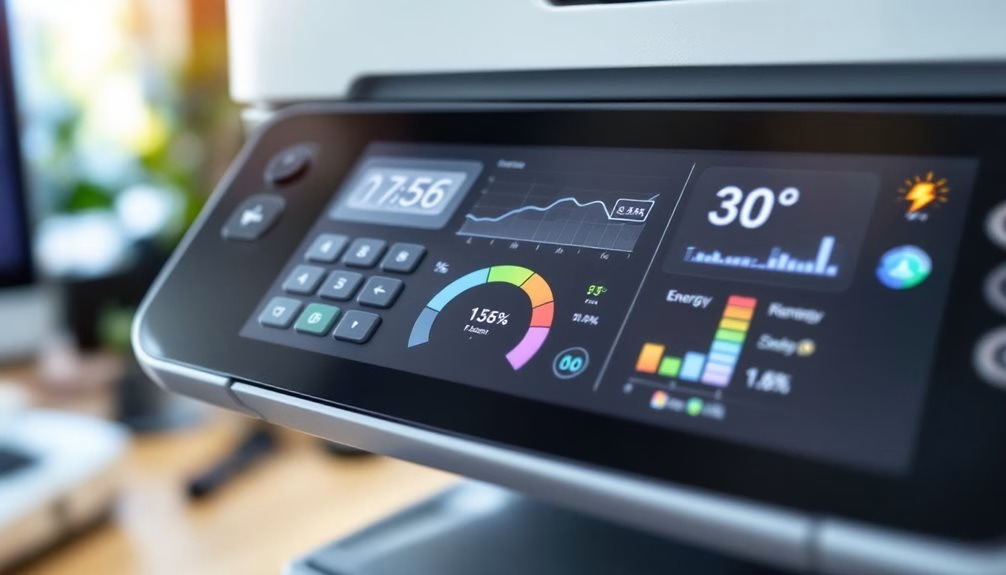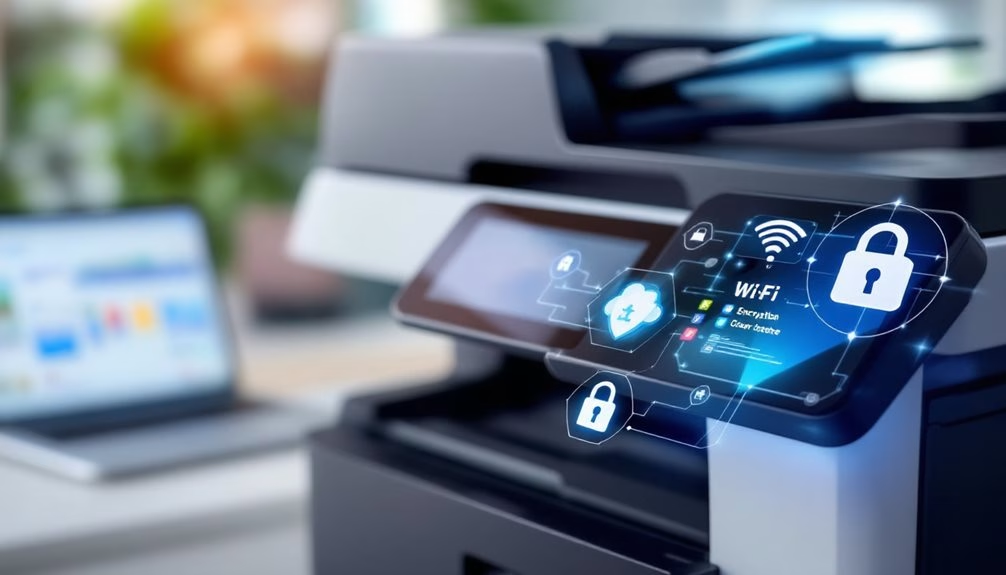We’ll help you find the perfect copier for your small business without wasting money on features you don’t need. It’s a decision that can greatly impact your daily operations and bottom line, whether you’re printing basic documents or producing professional marketing materials. By considering five key factors – from print volume to security requirements – you’ll be equipped to make a choice that serves your business well for years to come.
Expert Highlights
- Calculate your actual monthly print volume and patterns to choose a copier that matches your specific business needs.
- Consider essential features like automatic document feeding, duplex printing, and network connectivity for improved efficiency.
- Analyze total ownership costs, including maintenance agreements, supplies, and potential energy consumption before making a decision.
- Ensure adequate space and proper ventilation in a central location with enough clearance for maintenance access.
- Evaluate security features and network compatibility to protect sensitive documents and integrate with existing office infrastructure.
Assessing Your Monthly Print Volume and Usage Patterns

The first step in selecting the right copier is understanding your organization’s actual print volume and patterns.
Before investing in a copier, know exactly how much and what type of printing your organization truly needs.
Let’s track our daily and monthly printing habits to determine our true needs. We’ll want to count how many copies we make, noting peak usage times and any seasonal fluctuations.
We should examine whether we’re primarily printing single or double-sided, color or black-and-white, and what paper sizes we use most often.
Don’t forget to evaluate how many different team members use the copier and whether we need features like scanning, stapling, or hole punching.
Entry-level devices starting at premium brands offered like Canon, HP, Xerox, and Ricoh can accommodate most small business needs while providing reliable performance.
Key Features and Technology Options to Consider

When evaluating modern copiers, we’ll need to focus on several essential technological features that can dramatically impact our workflow efficiency.
Let’s consider automatic document feeders (ADF) for quick scanning, duplex printing to save paper, and network connectivity for seamless sharing across our team.
We should also look at mobile printing capabilities, cloud integration, and security features to protect our sensitive documents.
Today’s advanced finishing options like stapling, hole-punching, and collating can save us valuable time.
Additionally, color quality, resolution settings, and user-friendly touchscreen interfaces will guarantee we’re making a smart investment for our small business needs.
Choosing the right multi-function printer can lower total costs by up to 30% compared to traditional single-function devices while boosting productivity.
Understanding Total Cost of Ownership

Smart business owners know that purchasing price is just the beginning when calculating copier costs. We need to evaluate all expenses over the copier’s lifetime to make the best decision for our business. Total cost of ownership helps us understand the true financial impact of our investment.
- Monthly service agreements, including maintenance, parts, and labor, typically range from $50-$300 depending on usage.
- Supply costs like toner, paper, and replacement components can exceed $1,000 annually.
- Energy consumption varies greatly between models, impacting utility bills and environmental footprint.
Let’s factor in these ongoing costs to select a copier that fits our budget long-term.
Implementing Managed Print Services can reduce your total printing expenses by up to 30% through improved device usage and streamlined supply management.
Space Requirements and Physical Placement

Choosing the perfect spot for your copier involves more than just finding an empty corner. Let’s consider placement factors that’ll keep your team productive and your machine running smoothly.
| Location Factor | Why It Matters | Best Practice |
|---|---|---|
| Ventilation | Prevents overheating | 6″ clearance minimum |
| Traffic Flow | Enables accessibility | Central, open area |
| Power Source | Guarantees stability | Dedicated circuit |
Remember to measure both the copier’s footprint and surrounding workspace needed for paper loading and maintenance. We’ll want about 3 feet of clearance on all sides for easy access. Consider noise levels too – placing the copier away from quiet work areas helps maintain office harmony. Our factory-trained technicians can provide guidance on optimal placement to ensure your equipment maintains peak performance.
Connectivity and Security Considerations

Modern copiers function as sophisticated network devices, requiring careful consideration of both connectivity options and security protocols.
When we integrate a copier into our office network, we need to guarantee it aligns with our existing infrastructure while maintaining data security.
Today’s copiers can connect through ethernet, Wi-Fi, or cloud services, making them versatile but potentially vulnerable.
- Configure encrypted connections and secure printing features to protect sensitive documents from unauthorized access
- Set up user authentication systems to track usage and restrict access to specific functions
- Regularly update firmware and security settings to guard against emerging cybersecurity threats
For business security compliance, remember that print job content is automatically deleted within 24 hours after service completion.
Frequently Asked Questions
How Long Does a Typical Office Copier Last Before Needing Replacement?
We generally expect office copiers to last between 5-7 years, but that’s with regular maintenance. If we’re using them heavily, printing over 10,000 pages monthly, they might need replacing sooner.
What Happens to My Data When I Return a Leased Copier?
We’ll need to securely wipe the copier’s hard drive before returning it, since modern copiers store digital copies of everything we print. Let’s protect our data by requesting professional data removal.
Can Office Copiers Handle Specialty Paper Like Cardstock and Labels?
We’ll help you print on specialty paper! Most modern office copiers can handle cardstock and labels, but you’ll want to check your machine’s specifications and use the correct paper tray settings.
Are Maintenance Contracts Necessary, or Can Repairs Be Handled Independently?
We recommend maintenance contracts since today’s copiers are complex machines with specialized parts. While you can handle basic maintenance, professional technicians have the expertise and parts access for serious repairs.
What Environmental Certifications Should I Look for in an Eco-Friendly Copier?
We recommend looking for copiers with ENERGY STAR, EPEAT, Blue Angel, or Nordic Swan labels. These certifications guarantee your machine meets strict standards for energy efficiency and eco-friendly materials.
Expert Final Thoughts
We’ve explored the essential factors in choosing the right copier for your small business. By evaluating print volume, key features, total costs, space requirements, and security needs, we’re confident you can make an informed decision. Let’s remember that the perfect copier isn’t just about price – it’s about finding a solution that grows with your business while meeting your daily operational demands.
About the Expert
Rafael M.
CEO of JR Copier
With over 35 years of hands-on experience in the copier and office printer industry, Rafael brings unparalleled expertise to every client interaction. His journey from service technician to CEO provides him with comprehensive understanding of all aspects of the business.
Areas of Expertise: Copier and printer sales, equipment leasing strategies, maintenance solutions, and managed print services. Rafael's deep industry knowledge ensures clients receive expert guidance, transparent pricing, and exceptional service for all their office equipment needs.
Connect on LinkedIn